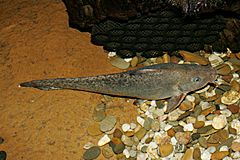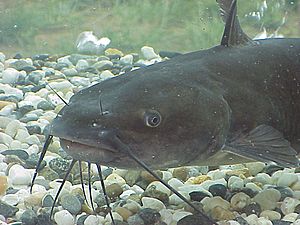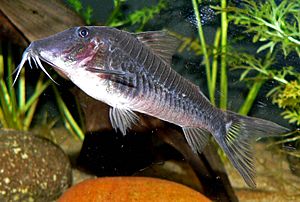Catfish facts for kids
Quick facts for kids CatfishTemporal range:
Upper Cretaceous – Recent |
|
|---|---|
 |
|
| Eel-tail catfish | |
| Scientific classification | |
| Kingdom: | |
| Phylum: | |
| Class: | |
| Superorder: |
Ostariophysi
|
| Order: |
Siluriformes
|
Catfish are a special group of fish known as Siluriformes. They get their name from their long, whisker-like feelers called barbels, which look a lot like a cat's whiskers! There are about 40 different families of catfish, and they are a very diverse group of bony fish.
Catfish come in all shapes and sizes. Some are huge, like the Mekong giant catfish from Southeast Asia or the wels catfish from Europe. Others are tiny, like the candiru, which is a very small species. Some catfish have tough, bony plates like armor, while others have smooth, naked skin without scales. Even though they are called catfish, not all of them have obvious barbels. What truly makes a fish a catfish are specific features of its skull and swimbladder.
Many large catfish are important for food, either caught by fishermen or raised on farms. Smaller catfish, especially the Corydoras species, are very popular in aquariums.
Contents
Where Do Catfish Live?
Catfish live in fresh or coastal waters on every continent except Antarctica. They are most common in warm, tropical areas like South America, Africa, and Asia. More than half of all catfish species live in the Americas. They are also the only type of fish that have made their way into freshwater habitats in places like Madagascar, Australia, and New Guinea.
You can find catfish mostly in all kinds of freshwater environments. Many prefer shallow, moving water. Some species even live underground or in caves! This makes them very successful at living in dark, hidden places. A few types of catfish can also be found in salty ocean water.
What Do Catfish Look Like?
Body Features of Catfish
Most catfish are built to live near the bottom of the water. They tend to sink rather than float because they have a small gas bladder and a heavy, bony head. Catfish have many different body shapes, but most have a rounded body that is flat on the bottom. This helps them feed on the riverbed.
Their flat heads help them dig through the mud or sand. Most catfish have a mouth that can open very wide and doesn't have sharp, cutting teeth. They usually eat by sucking in or gulping their food, instead of biting it. However, some families, like the Loricariidae, have a special suckermouth that lets them stick to rocks in fast-moving water. Catfish also have small barbels near their mouth, which they use to find food.

Catfish can have up to four pairs of barbels: one pair near their nose, one pair on each side of their mouth, and two pairs under their chin. Some species might have fewer or no barbels. Because their barbels are so good at finding food, catfish usually have small eyes. They also have a special inner ear structure that helps them hear well and even make sounds.

Catfish do not have scales. Their bodies are often smooth and naked. In some species, their mucus-covered skin can even help them breathe underwater. Some catfish have bony plates called scutes covering their skin, like a suit of armor. This body armor has developed many times in different catfish groups.
Almost all catfish have a strong, hollow, spine-like ray on their dorsal (top) and pectoral fins (side fins). They can lock these spines into place as a defense, which can cause painful wounds. Some catfish species can even release a stinging protein from these spines if they feel threatened. This venom is made by special cells in their skin. For some catfish, like the Plotosus lineatus, a sting can be very serious and might even need hospital care.
Young catfish look a lot like adult catfish, just smaller. Their heads, eyes, and fins are usually bigger in proportion to their bodies when they are young. Most catfish grow smoothly into their adult form without big changes.
How Big Can Catfish Get?
Catfish have one of the widest ranges in size among all bony fish. Many catfish species are less than 12 centimeters (about 5 inches) long. Some of the smallest ones are fully grown at just 1 centimeter (less than half an inch)!
On the other hand, the wels catfish from Europe can grow very large. While old stories talk about huge wels catfish, most are about 1.2 to 1.6 meters (4 to 5 feet) long. Fish over 2 meters (6.5 feet) are rare. The biggest ones ever recorded were more than 2.5 meters (8 feet) long and weighed over 100 kilograms (220 pounds)!
In the United States, a blue catfish caught in the Mississippi River weighed 124 pounds (56 kg). A flathead catfish caught in Kansas weighed 123 pounds (56 kg). But these are small compared to a Mekong giant catfish caught in Thailand in 2005. This huge fish weighed 293 kilograms (646 pounds)! It was the largest giant Mekong catfish recorded since 1981.
Catfish as Food

People have been catching and farming catfish for food for hundreds of years in Africa, Asia, Europe, and North America. Some people love the taste of catfish, while others find it a bit plain. In Central Europe, catfish used to be a special dish for holidays. This tradition came to the southern U.S., where catfish is now a very popular food.
The most common types eaten in the U.S. are the channel catfish and blue catfish. These are found in the wild and are also widely farmed. Catfish can be cooked in many ways. In Europe, it's often cooked like carp. In the U.S., it's usually coated in cornmeal and fried.
In Indonesia, catfish is a popular dish called Pecel Lele, often served grilled at street stalls. In Malaysia, it's called "Ikan Keli" and is usually fried with spices and eaten with rice. The iridescent shark is another common food fish in parts of Asia.
Catfish Farming
Catfish are easy to farm in warm places, which makes them an affordable and safe food. In North America, especially in the southern U.S., catfish farms are very common. Mississippi is the biggest producer of farmed catfish in the U.S. The channel catfish supports a huge farming industry worth about $450 million each year.
Farming catfish in tanks or channels is considered good for the environment. This is because their waste and any diseases are kept contained and don't spread to wild fish.
In Asia, many catfish species are important food sources. Several types of walking catfish and shark catfish are farmed a lot in Africa and Asia. For example, a type of shark catfish from Vietnam, Pangasius bocourti, is often sold as "basa fish" in the U.S. because of trade rules.
Catfish are also very popular as ornamental fish for aquariums. Hundreds of species, like Corydoras and armored suckermouth catfish (often called plecos), are kept as pets. Other popular aquarium catfish include banjo catfish and long-whiskered catfish.
Special Catfish Abilities
Most catfish are harmless to people. However, some have unique abilities. The candiru is a tiny parasitic catfish that normally attaches to the gills of other fish.
The Malapteruridae family are known as electric catfish. Several species in this family can produce a powerful electric shock of up to 350 volts! They do this using special organs in their bodies.
Images for kids
-
Giant Bagarius yarrelli (goonch) caught in India: some goonch in the Kali River grow large enough to attack humans and water buffalo
-
Fried catfish from the cuisine of New Orleans
-
Pecel lele served with sambal, tempeh and lalab vegetables in a tent warung in Jakarta, Indonesia
-
Blue catfish (Ictalurus furcatus) skeleton on display at the Museum of Osteology.
See also
 In Spanish: Pez gato para niños
In Spanish: Pez gato para niños









